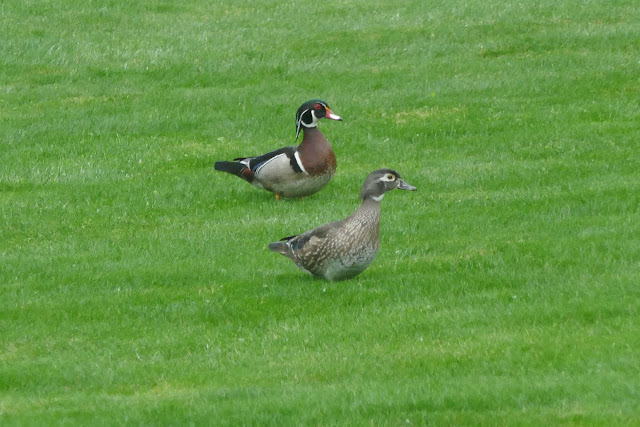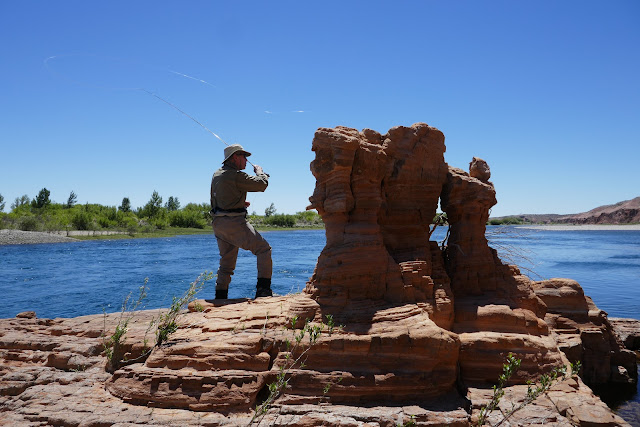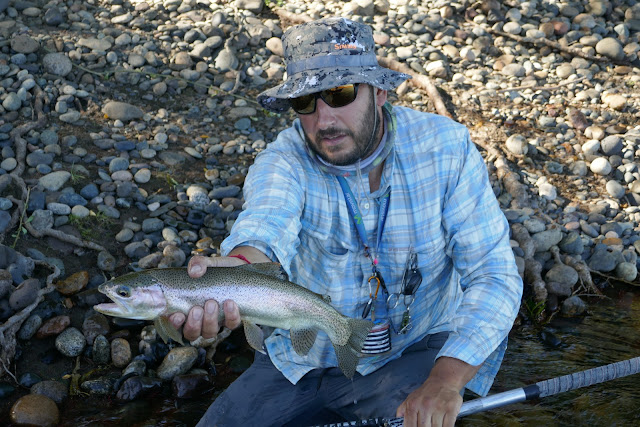I feed the deer corn and apples (see below) most of the winter in an effort to locally prevent any die off from starvation. I can't do much about the coyotes, who MNR says kill about 70% of the fawns each year, but as you see the deer are always vigilant. Also, the wooded part of our house property (100 acres) is covered in white cedar and young aspen, the browse of which likely serves as their primary source of protein and minerals.
As the snow and ice recede, the first birds to return each year to our ponds is our 'resident' goose pair. Even with the ice still on, every year they lay claim to both the trout pond, Emerald (< 1 acre) and the adjacent water fowl lake,Windigo (~10 acres). The gander below appears to be modelling Jock Wilcox's great blue heron, which normally is not under water.
The pair initially feed and groom in the trout pond.
With the recession of more snow, they spend more time sitting on a log defending the big pond,Windigo.
This is the time of the year when I plant the fingerling trout in Emerald Pond, if it is the right year to do so (every other year). Last spring was the right year (2017), which was described in an early posting. Below you see one freshly introduced rainbow trout bracketed by 3 brook trout immediately after planting.
Soon to follow the returning geese are the male mallards. First one, and then
and then many more
The geese have no problem sharing with the ducks, just other geese! If any other geese pairs circle to land, they will immediately take to flight to chase them away. Note the hooded merganser female on the rock at the left.
My favorite returning ducks, however, are the wood ducks. Theoretically they have paired up before they return to the north country, but there are always a number of males who hang around the mated pairs and apparently live ever-hopeful that they might have an opportunity with the hen.
And here a woodie pair is being followed by a couple of males hoping to get lucky.
To facilitate their breeding success, I have built 4 nesting boxes for them. All 4 get used every year. The game camera has captured the hen entering one of the nests. Sometimes 2 hens, at different times of the day, will use the same box. Note the male standing guard, which only occasionally happens. Most often he sits in the nearest pond to that particular nest and waits for her to lay her single egg for the day. Then they fly off together.
I am always impressed when a hen daily returns to the nest to lay another egg. She flies into the nest at great speed with very little slowing down.
This year 2 of the 4 nests were shared with female hooded mergansers, who also like the nesting boxes. They are fish eating ducks with a hooked bill for grabbing minnows. The female has a reddish hood seen below, while the male's hood is black with a big white circle on each side. They look quite different from each other.
After the nesting period has passed in late June, I open the boxes to see how well the birds have done. I check the number of broken shells, suggesting successful hatching, and the number of unhatched eggs. All boxes had 6-12 broken shells this year, while two had 2 unhatched eggs each. Interestingly, in each of those two nests, there was one wood duck egg and one merganser egg. Looking down into one of the nests, the intact brown merganser egg can be seen among the broken white woodie shells, cushioned by my wood chips and blended with the down feathers from the mothers' chest.
Removing the unhatched eggs, you an see the relative size of the two woodie eggs compared to my drill battery.
Or compared to the smaller two brown merganser eggs on the back of the UTV.
This past spring, at about this time, I was mentioning to my daughter-in-law, Tracey, that I would like to get my hands on a pair of Muscovy ducks, who normally hang around all summer and do not disappear like the wild birds. Tracey knows a woman who raises them and would inquire on my behalf.
Much to my surprise, a couple of days later, I returned home from the cottage and discovered a Muscovy in the yard hanging out with the geese. I thanked Tracey for the bird, but she said she had nothing to do with it! What?? We have still never figured out the origin of the bird. None of the neighbors had birds. I suspected that it would go away as quickly as it came, but not so. The bird wasn't as big as the male Muscovy's I had raised in previous years, so we assumed it was a female and we named her Mabel. Within a few weeks, the geese had disappeared and Mabel (below) was alone. As she was alone, we checked again with the person raising the Muscovy's so many miles away to she if she a potential companion for Mabel. She had a infertile white hen she as happy to offload to me.
After introducing the new white Muscovy to Mabel, the new bird was quickly mounted (after all it was still spring and the Muscovy's are sexually active until August). Thus Mabel became Marvin, and the new white hen was now Mabel. They soon became buddies for the rest of the season.
One of my favorite spring visitors is the rose breasted grosbeak. He would come to the feeder every day, and if there wasn't food in it, he would sit there and look at me til I got up from my chair and returned with the sunflower seeds. Cheeky but cute.
Perhaps my favorite all season regular is the mourning dove. Although they can be annoy for those with good hearing, unfortunately for me this is no longer a problem!
And sap!! Apparently I am going to have to improve my Ninja moves if I am going dodge lethal missiles coming my way in the future. By its location, this one appears to have been delivered by a professional assassin.
The other birds that frequent the yard in the spring, and on into the summer and fall, are the wild turkeys. They like my corn, but not the apples, and frequently before planting go through the raised gardens for bugs.
They are also fond of the 2 small fields (1 and 2 acres) that I have planted with clover, alfalfa and various grasses for them and the deer. They begin working there in the early spring before much has emerged from the wet ground. Last year much of this field simply drowned from the relentless rain (an earlier posting). It did grow up later in the summer with lots of weeds that they enjoyed.
After grooming the fields for food, often they roost for the night in the large poplars immediate next to the field. In this case, right behind the wood duck nest closest to the house.
and most often just at sunset.
And if it is still spring, the tom turkeys will be there too, always hoping to impress one of the fertile hens. Most of the time, the hens ignore him. However, this not true all of the time, as most hens show up later with a clutch of 6-10 chicks at some time during the early summer.
To get to this point, however, the hen has to avoid her nest being discovered either by the male (as he will destroy the eggs to keep her in a state of breeding), or the many egg predators including fox, coyote, raccoon, mink, skunk, fisher and others! Once the chicks hatch, they have a much better chance to survive as, unlike many of our other avian visitors, they can fly immediately.
As you can see, there is lots of avian wildlife activity here to amuse me from early spring into late fall, when again many of them leave for warmer surrounds -- as I would like to also!



























































